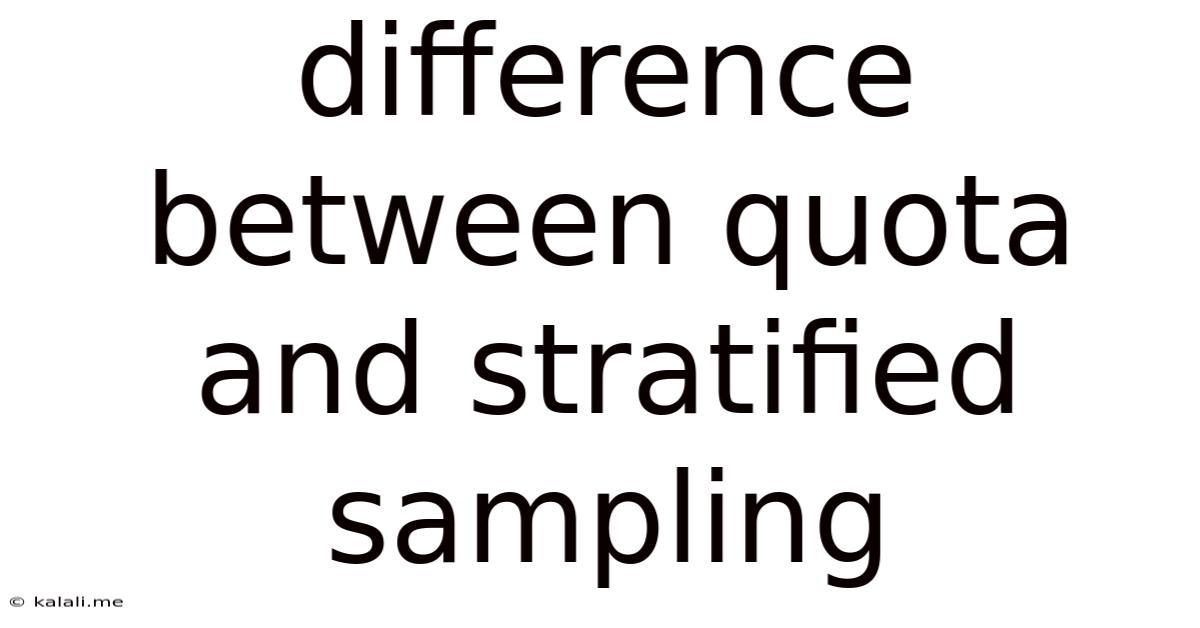Difference Between Quota And Stratified Sampling
Kalali
Jun 11, 2025 · 3 min read

Table of Contents
Quota vs. Stratified Sampling: Unveiling the Differences for Accurate Research
Choosing the right sampling method is crucial for obtaining reliable and representative results in any research project. Two popular probability sampling techniques, quota sampling and stratified sampling, are often confused due to their similarities. However, understanding their key differences is essential for ensuring the validity and accuracy of your findings. This article will delve into the nuances of quota and stratified sampling, highlighting their strengths and weaknesses to help you make an informed decision for your research needs.
What is Quota Sampling?
Quota sampling is a non-probability sampling technique where researchers create subgroups based on specific characteristics (quotas) within a population. These characteristics might include age, gender, ethnicity, or socioeconomic status. The researchers then collect data from participants within each subgroup until the predetermined quota for each group is filled. The selection of individuals within each quota is typically done using convenience sampling—selecting participants who are readily available.
Advantages of Quota Sampling:
- Cost-effective and time-efficient: It's generally faster and cheaper than probability sampling methods because it doesn't require a complete sampling frame.
- Easy to implement: The straightforward methodology makes it accessible for researchers with limited resources.
- Representation of subgroups: Ensures representation of key demographic or other relevant characteristics within the sample.
Disadvantages of Quota Sampling:
- Sampling bias: The reliance on convenience sampling within quotas introduces potential bias, as the selected participants may not accurately represent the population within those quotas. This impacts the generalizability of the findings.
- No random selection: The lack of random selection prevents researchers from making statistically valid inferences about the entire population.
- Potential for researcher bias: The subjective nature of choosing participants within quotas can lead to unconscious biases from the researcher.
What is Stratified Sampling?
Stratified sampling is a probability sampling technique where the population is divided into mutually exclusive subgroups (strata) based on relevant characteristics. Unlike quota sampling, every member of the population has a known and non-zero chance of being selected. A random sample is then drawn from each stratum, proportionally or disproportionately to its size within the population. Proportional stratified sampling ensures the sample reflects the population's proportions; disproportionate stratified sampling allows oversampling smaller strata for more in-depth analysis.
Advantages of Stratified Sampling:
- Reduced sampling error: By ensuring representation from all strata, stratified sampling reduces the sampling error and increases the precision of estimates.
- Enhanced representativeness: Provides a more accurate representation of the population compared to simple random sampling, especially when dealing with heterogeneous populations.
- Allows for subgroup analysis: Facilitates the comparison of different subgroups and the investigation of relationships between variables within specific strata.
- Statistically sound inferences: Because of the random sampling component, researchers can make statistically valid inferences about the entire population.
Disadvantages of Stratified Sampling:
- Requires a complete sampling frame: A comprehensive list of the population is necessary to identify and sample from each stratum, which can be challenging or impossible to obtain.
- More complex than simple random sampling: It requires more planning and execution than simple random sampling.
- Potential for increased costs: The complexities involved can potentially increase the time and financial resources required.
Key Differences Summarized:
| Feature | Quota Sampling | Stratified Sampling |
|---|---|---|
| Sampling Type | Non-probability | Probability |
| Selection | Convenience within quotas | Random within strata |
| Sampling Frame | Not required | Required |
| Representation | Approximates population proportions | Precisely represents population proportions (proportional) |
| Statistical Inference | Not statistically valid | Statistically valid |
Conclusion:
While both quota and stratified sampling aim to represent subgroups within a population, the crucial difference lies in the method of selection. Stratified sampling, through its random selection process, offers a more robust and statistically sound approach, leading to more reliable and generalizable research findings. However, quota sampling can be a practical option when resources are limited and a less rigorous approach is acceptable. The choice between these methods ultimately depends on the research objectives, available resources, and the desired level of accuracy.
Latest Posts
Latest Posts
-
How Many Apples In A 3 Pound Bag
Jul 01, 2025
-
How Many Pounds Is A Bushel Of Peanuts
Jul 01, 2025
-
How Many Pounds Are In 32 Ounces
Jul 01, 2025
-
What Year Would I Be Born If I Was 21
Jul 01, 2025
-
How Many Minutes Are In 40 Hours
Jul 01, 2025
Related Post
Thank you for visiting our website which covers about Difference Between Quota And Stratified Sampling . We hope the information provided has been useful to you. Feel free to contact us if you have any questions or need further assistance. See you next time and don't miss to bookmark.